EDU202 - Strength Based Inclusive Education Report, Semester 2
VerifiedAdded on 2023/06/08
|14
|3813
|143
Report
AI Summary
This report provides a comprehensive overview of strength-based inclusive education, focusing on its principles, legislative context, and practical implications for teachers in Australian schools. The introduction establishes the significance of inclusive education for children with special needs, emphasizing the right to education and the implementation of Individualized Education Plans (IEPs). The report delves into the legal frameworks supporting inclusive education, referencing UNESCO, the Melbourne Declaration, and the Salamanca Statement. It examines the needs of children with special needs, categorizing them into cognitive, affective, social, and psychomotor domains, and contrasts the traditional deficit-based model with the strength-based approach. The report then explores the implications for teachers, discussing learning theories such as Piaget's cognitive development and Bandura's self-efficacy, and the Universal Design for Learning (UDL) framework. Finally, a reflective log offers personal insights into the challenges and opportunities of inclusive education, based on the student's research and understanding of the subject.
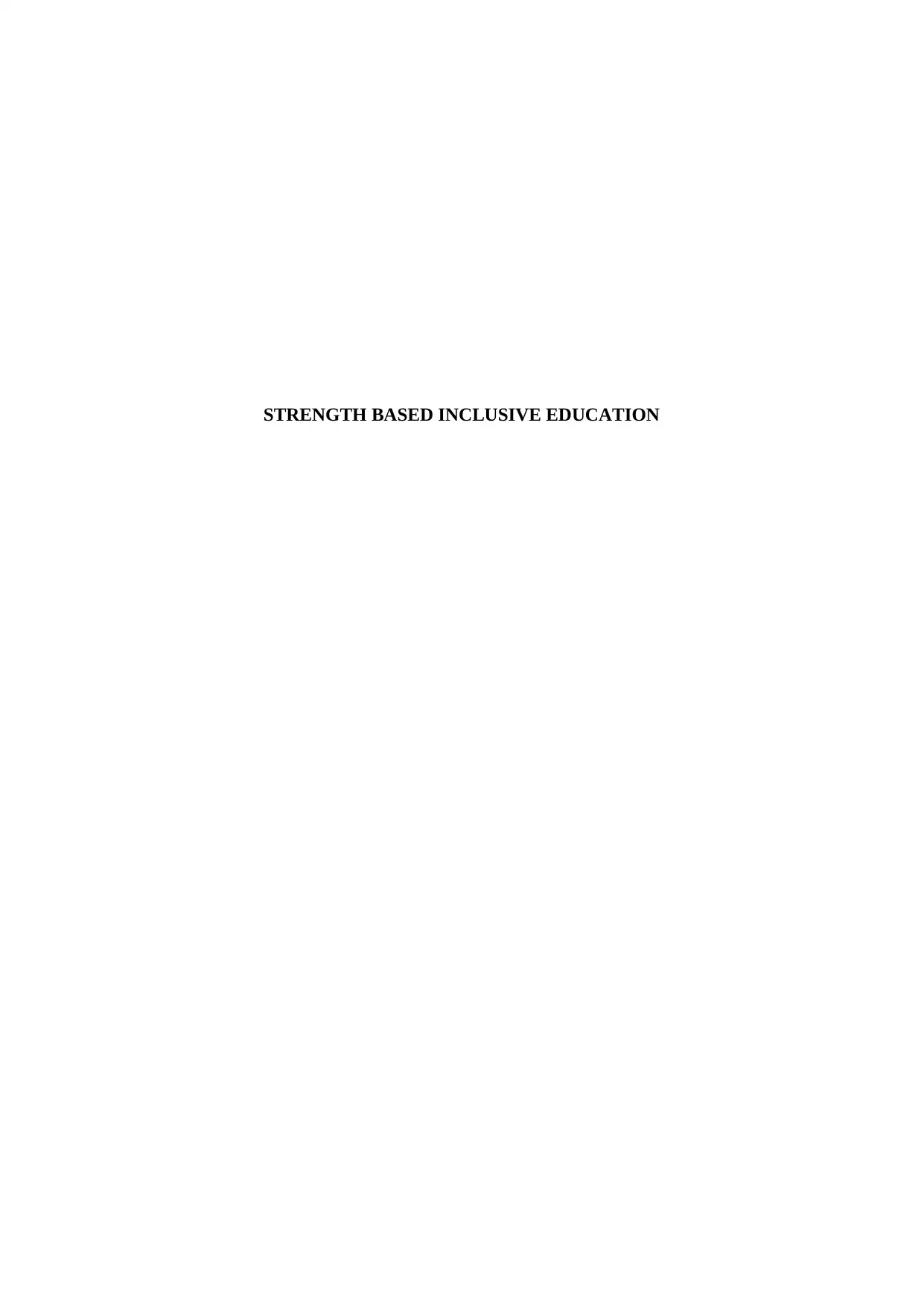
STRENGTH BASED INCLUSIVE EDUCATION
Paraphrase This Document
Need a fresh take? Get an instant paraphrase of this document with our AI Paraphraser
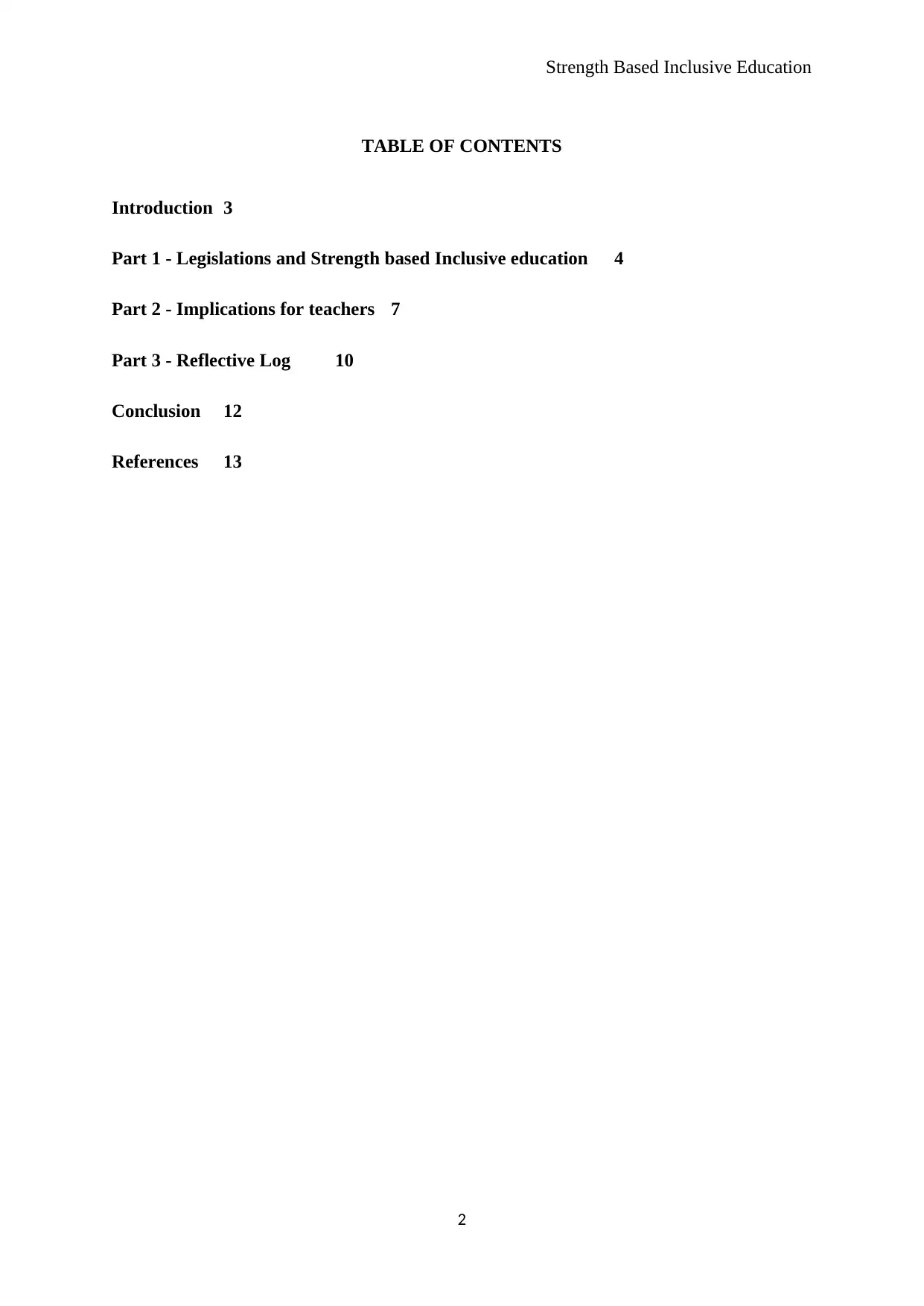
Strength Based Inclusive Education
TABLE OF CONTENTS
Introduction 3
Part 1 - Legislations and Strength based Inclusive education 4
Part 2 - Implications for teachers 7
Part 3 - Reflective Log 10
Conclusion 12
References 13
2
TABLE OF CONTENTS
Introduction 3
Part 1 - Legislations and Strength based Inclusive education 4
Part 2 - Implications for teachers 7
Part 3 - Reflective Log 10
Conclusion 12
References 13
2
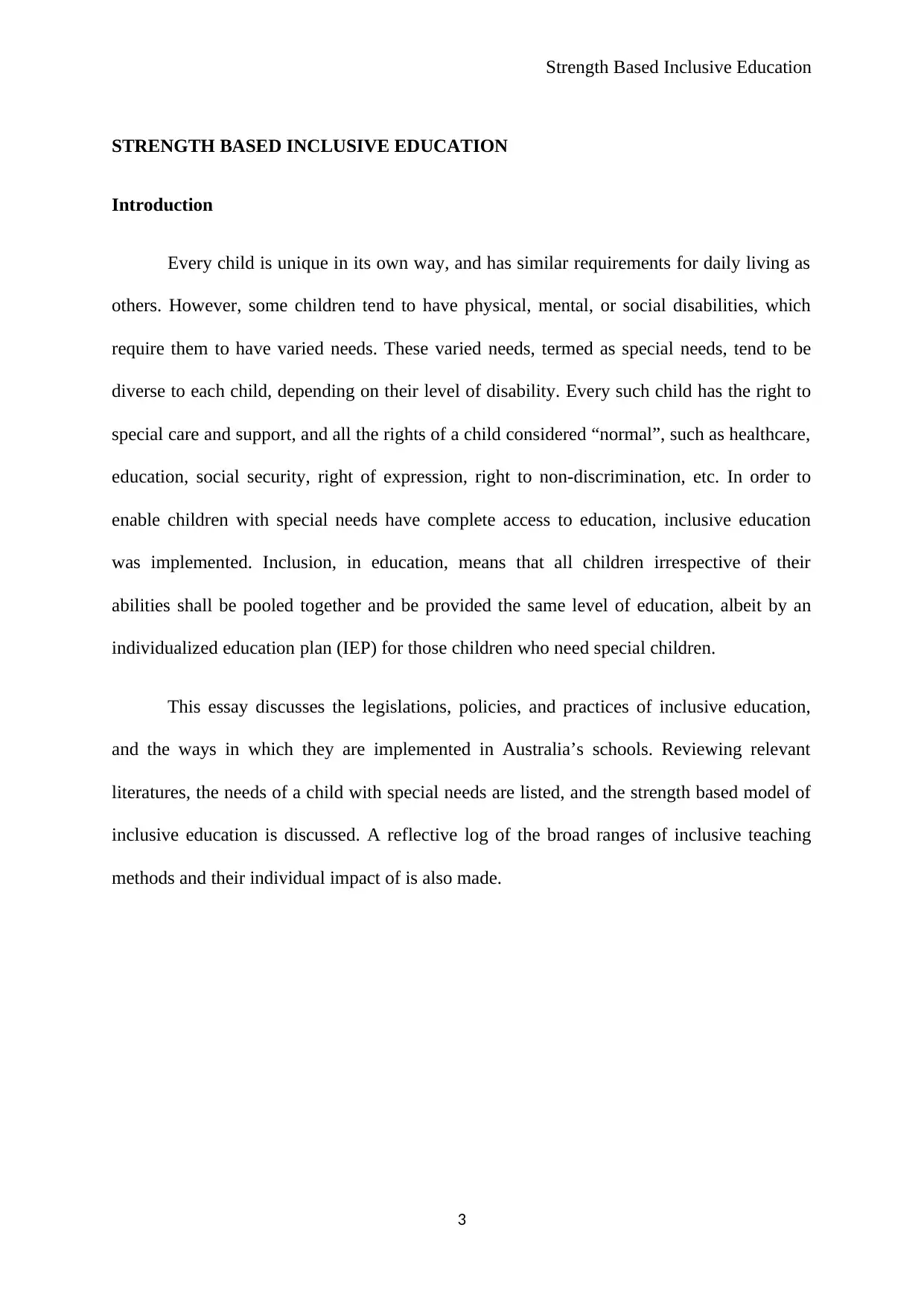
Strength Based Inclusive Education
STRENGTH BASED INCLUSIVE EDUCATION
Introduction
Every child is unique in its own way, and has similar requirements for daily living as
others. However, some children tend to have physical, mental, or social disabilities, which
require them to have varied needs. These varied needs, termed as special needs, tend to be
diverse to each child, depending on their level of disability. Every such child has the right to
special care and support, and all the rights of a child considered “normal”, such as healthcare,
education, social security, right of expression, right to non-discrimination, etc. In order to
enable children with special needs have complete access to education, inclusive education
was implemented. Inclusion, in education, means that all children irrespective of their
abilities shall be pooled together and be provided the same level of education, albeit by an
individualized education plan (IEP) for those children who need special children.
This essay discusses the legislations, policies, and practices of inclusive education,
and the ways in which they are implemented in Australia’s schools. Reviewing relevant
literatures, the needs of a child with special needs are listed, and the strength based model of
inclusive education is discussed. A reflective log of the broad ranges of inclusive teaching
methods and their individual impact of is also made.
3
STRENGTH BASED INCLUSIVE EDUCATION
Introduction
Every child is unique in its own way, and has similar requirements for daily living as
others. However, some children tend to have physical, mental, or social disabilities, which
require them to have varied needs. These varied needs, termed as special needs, tend to be
diverse to each child, depending on their level of disability. Every such child has the right to
special care and support, and all the rights of a child considered “normal”, such as healthcare,
education, social security, right of expression, right to non-discrimination, etc. In order to
enable children with special needs have complete access to education, inclusive education
was implemented. Inclusion, in education, means that all children irrespective of their
abilities shall be pooled together and be provided the same level of education, albeit by an
individualized education plan (IEP) for those children who need special children.
This essay discusses the legislations, policies, and practices of inclusive education,
and the ways in which they are implemented in Australia’s schools. Reviewing relevant
literatures, the needs of a child with special needs are listed, and the strength based model of
inclusive education is discussed. A reflective log of the broad ranges of inclusive teaching
methods and their individual impact of is also made.
3
⊘ This is a preview!⊘
Do you want full access?
Subscribe today to unlock all pages.

Trusted by 1+ million students worldwide
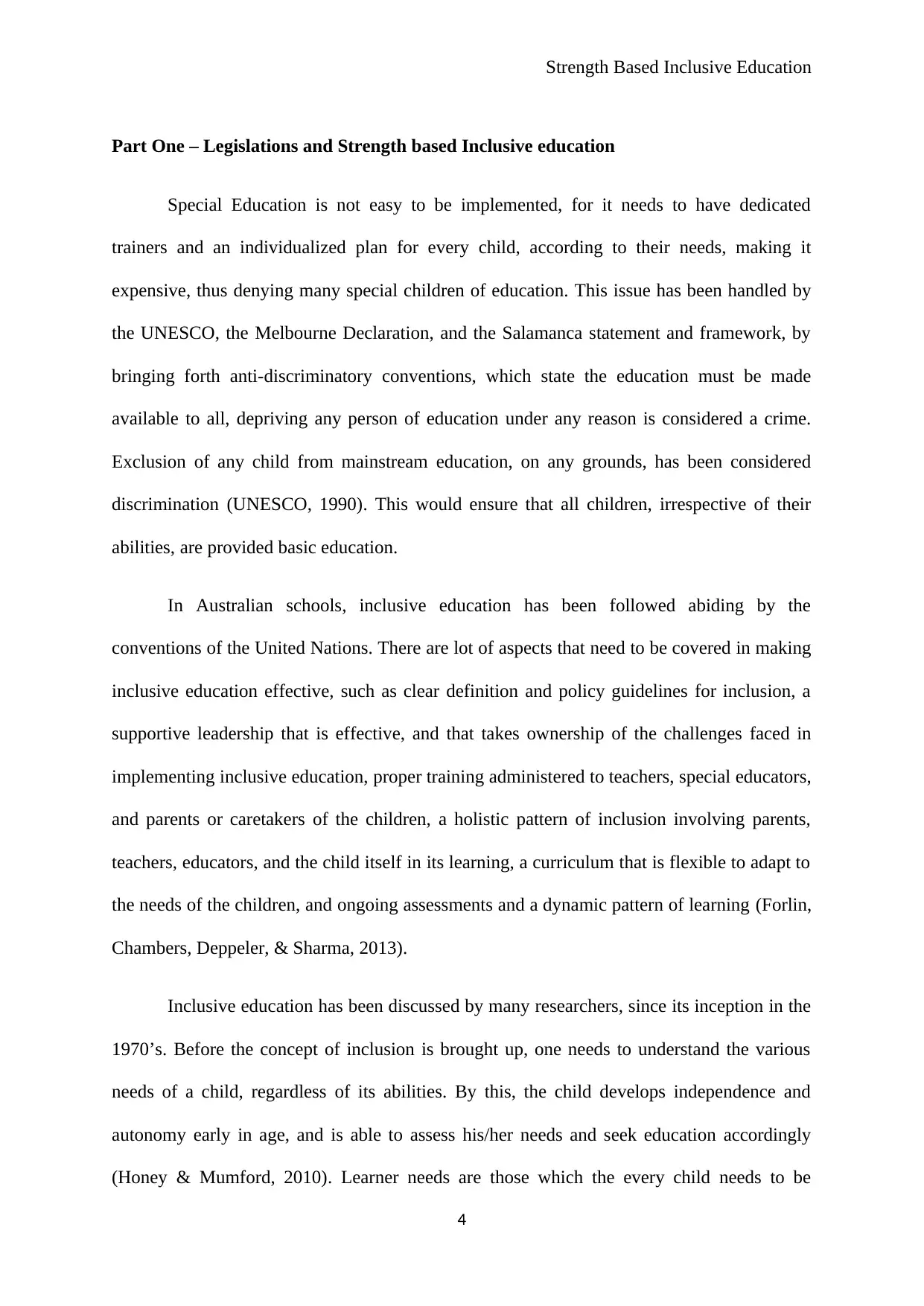
Strength Based Inclusive Education
Part One – Legislations and Strength based Inclusive education
Special Education is not easy to be implemented, for it needs to have dedicated
trainers and an individualized plan for every child, according to their needs, making it
expensive, thus denying many special children of education. This issue has been handled by
the UNESCO, the Melbourne Declaration, and the Salamanca statement and framework, by
bringing forth anti-discriminatory conventions, which state the education must be made
available to all, depriving any person of education under any reason is considered a crime.
Exclusion of any child from mainstream education, on any grounds, has been considered
discrimination (UNESCO, 1990). This would ensure that all children, irrespective of their
abilities, are provided basic education.
In Australian schools, inclusive education has been followed abiding by the
conventions of the United Nations. There are lot of aspects that need to be covered in making
inclusive education effective, such as clear definition and policy guidelines for inclusion, a
supportive leadership that is effective, and that takes ownership of the challenges faced in
implementing inclusive education, proper training administered to teachers, special educators,
and parents or caretakers of the children, a holistic pattern of inclusion involving parents,
teachers, educators, and the child itself in its learning, a curriculum that is flexible to adapt to
the needs of the children, and ongoing assessments and a dynamic pattern of learning (Forlin,
Chambers, Deppeler, & Sharma, 2013).
Inclusive education has been discussed by many researchers, since its inception in the
1970’s. Before the concept of inclusion is brought up, one needs to understand the various
needs of a child, regardless of its abilities. By this, the child develops independence and
autonomy early in age, and is able to assess his/her needs and seek education accordingly
(Honey & Mumford, 2010). Learner needs are those which the every child needs to be
4
Part One – Legislations and Strength based Inclusive education
Special Education is not easy to be implemented, for it needs to have dedicated
trainers and an individualized plan for every child, according to their needs, making it
expensive, thus denying many special children of education. This issue has been handled by
the UNESCO, the Melbourne Declaration, and the Salamanca statement and framework, by
bringing forth anti-discriminatory conventions, which state the education must be made
available to all, depriving any person of education under any reason is considered a crime.
Exclusion of any child from mainstream education, on any grounds, has been considered
discrimination (UNESCO, 1990). This would ensure that all children, irrespective of their
abilities, are provided basic education.
In Australian schools, inclusive education has been followed abiding by the
conventions of the United Nations. There are lot of aspects that need to be covered in making
inclusive education effective, such as clear definition and policy guidelines for inclusion, a
supportive leadership that is effective, and that takes ownership of the challenges faced in
implementing inclusive education, proper training administered to teachers, special educators,
and parents or caretakers of the children, a holistic pattern of inclusion involving parents,
teachers, educators, and the child itself in its learning, a curriculum that is flexible to adapt to
the needs of the children, and ongoing assessments and a dynamic pattern of learning (Forlin,
Chambers, Deppeler, & Sharma, 2013).
Inclusive education has been discussed by many researchers, since its inception in the
1970’s. Before the concept of inclusion is brought up, one needs to understand the various
needs of a child, regardless of its abilities. By this, the child develops independence and
autonomy early in age, and is able to assess his/her needs and seek education accordingly
(Honey & Mumford, 2010). Learner needs are those which the every child needs to be
4
Paraphrase This Document
Need a fresh take? Get an instant paraphrase of this document with our AI Paraphraser
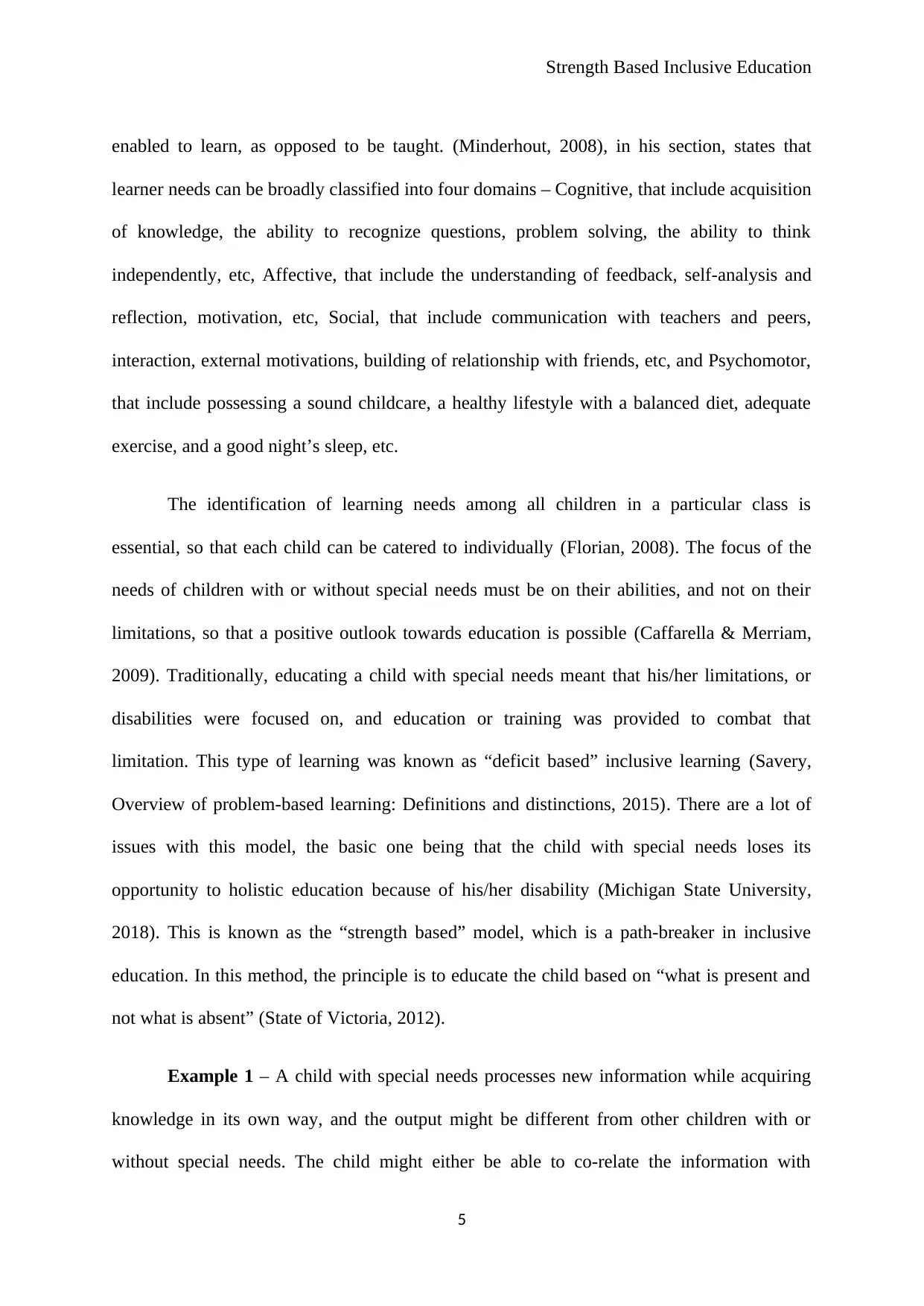
Strength Based Inclusive Education
enabled to learn, as opposed to be taught. (Minderhout, 2008), in his section, states that
learner needs can be broadly classified into four domains – Cognitive, that include acquisition
of knowledge, the ability to recognize questions, problem solving, the ability to think
independently, etc, Affective, that include the understanding of feedback, self-analysis and
reflection, motivation, etc, Social, that include communication with teachers and peers,
interaction, external motivations, building of relationship with friends, etc, and Psychomotor,
that include possessing a sound childcare, a healthy lifestyle with a balanced diet, adequate
exercise, and a good night’s sleep, etc.
The identification of learning needs among all children in a particular class is
essential, so that each child can be catered to individually (Florian, 2008). The focus of the
needs of children with or without special needs must be on their abilities, and not on their
limitations, so that a positive outlook towards education is possible (Caffarella & Merriam,
2009). Traditionally, educating a child with special needs meant that his/her limitations, or
disabilities were focused on, and education or training was provided to combat that
limitation. This type of learning was known as “deficit based” inclusive learning (Savery,
Overview of problem-based learning: Definitions and distinctions, 2015). There are a lot of
issues with this model, the basic one being that the child with special needs loses its
opportunity to holistic education because of his/her disability (Michigan State University,
2018). This is known as the “strength based” model, which is a path-breaker in inclusive
education. In this method, the principle is to educate the child based on “what is present and
not what is absent” (State of Victoria, 2012).
Example 1 – A child with special needs processes new information while acquiring
knowledge in its own way, and the output might be different from other children with or
without special needs. The child might either be able to co-relate the information with
5
enabled to learn, as opposed to be taught. (Minderhout, 2008), in his section, states that
learner needs can be broadly classified into four domains – Cognitive, that include acquisition
of knowledge, the ability to recognize questions, problem solving, the ability to think
independently, etc, Affective, that include the understanding of feedback, self-analysis and
reflection, motivation, etc, Social, that include communication with teachers and peers,
interaction, external motivations, building of relationship with friends, etc, and Psychomotor,
that include possessing a sound childcare, a healthy lifestyle with a balanced diet, adequate
exercise, and a good night’s sleep, etc.
The identification of learning needs among all children in a particular class is
essential, so that each child can be catered to individually (Florian, 2008). The focus of the
needs of children with or without special needs must be on their abilities, and not on their
limitations, so that a positive outlook towards education is possible (Caffarella & Merriam,
2009). Traditionally, educating a child with special needs meant that his/her limitations, or
disabilities were focused on, and education or training was provided to combat that
limitation. This type of learning was known as “deficit based” inclusive learning (Savery,
Overview of problem-based learning: Definitions and distinctions, 2015). There are a lot of
issues with this model, the basic one being that the child with special needs loses its
opportunity to holistic education because of his/her disability (Michigan State University,
2018). This is known as the “strength based” model, which is a path-breaker in inclusive
education. In this method, the principle is to educate the child based on “what is present and
not what is absent” (State of Victoria, 2012).
Example 1 – A child with special needs processes new information while acquiring
knowledge in its own way, and the output might be different from other children with or
without special needs. The child might either be able to co-relate the information with
5
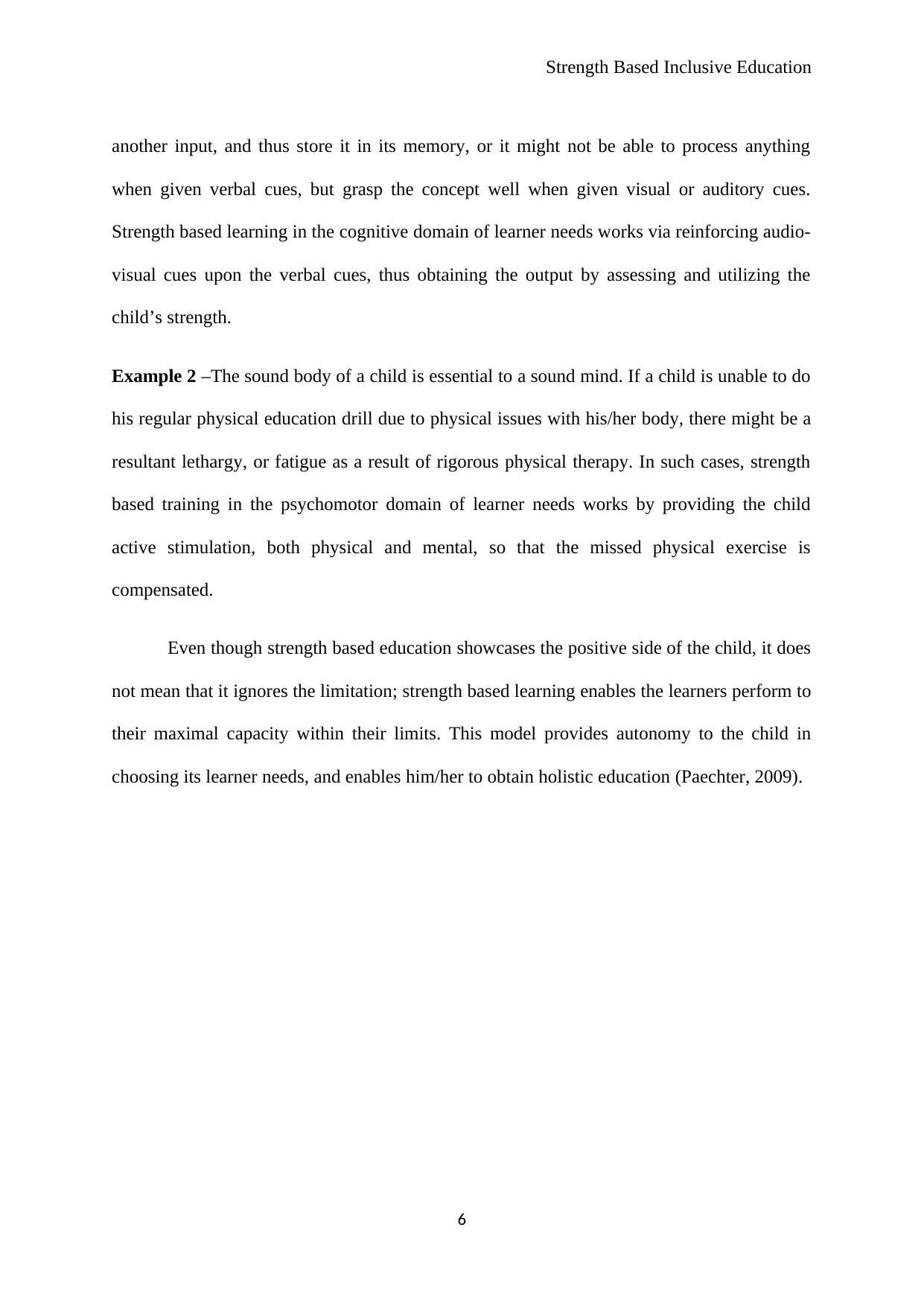
Strength Based Inclusive Education
another input, and thus store it in its memory, or it might not be able to process anything
when given verbal cues, but grasp the concept well when given visual or auditory cues.
Strength based learning in the cognitive domain of learner needs works via reinforcing audio-
visual cues upon the verbal cues, thus obtaining the output by assessing and utilizing the
child’s strength.
Example 2 –The sound body of a child is essential to a sound mind. If a child is unable to do
his regular physical education drill due to physical issues with his/her body, there might be a
resultant lethargy, or fatigue as a result of rigorous physical therapy. In such cases, strength
based training in the psychomotor domain of learner needs works by providing the child
active stimulation, both physical and mental, so that the missed physical exercise is
compensated.
Even though strength based education showcases the positive side of the child, it does
not mean that it ignores the limitation; strength based learning enables the learners perform to
their maximal capacity within their limits. This model provides autonomy to the child in
choosing its learner needs, and enables him/her to obtain holistic education (Paechter, 2009).
6
another input, and thus store it in its memory, or it might not be able to process anything
when given verbal cues, but grasp the concept well when given visual or auditory cues.
Strength based learning in the cognitive domain of learner needs works via reinforcing audio-
visual cues upon the verbal cues, thus obtaining the output by assessing and utilizing the
child’s strength.
Example 2 –The sound body of a child is essential to a sound mind. If a child is unable to do
his regular physical education drill due to physical issues with his/her body, there might be a
resultant lethargy, or fatigue as a result of rigorous physical therapy. In such cases, strength
based training in the psychomotor domain of learner needs works by providing the child
active stimulation, both physical and mental, so that the missed physical exercise is
compensated.
Even though strength based education showcases the positive side of the child, it does
not mean that it ignores the limitation; strength based learning enables the learners perform to
their maximal capacity within their limits. This model provides autonomy to the child in
choosing its learner needs, and enables him/her to obtain holistic education (Paechter, 2009).
6
⊘ This is a preview!⊘
Do you want full access?
Subscribe today to unlock all pages.

Trusted by 1+ million students worldwide
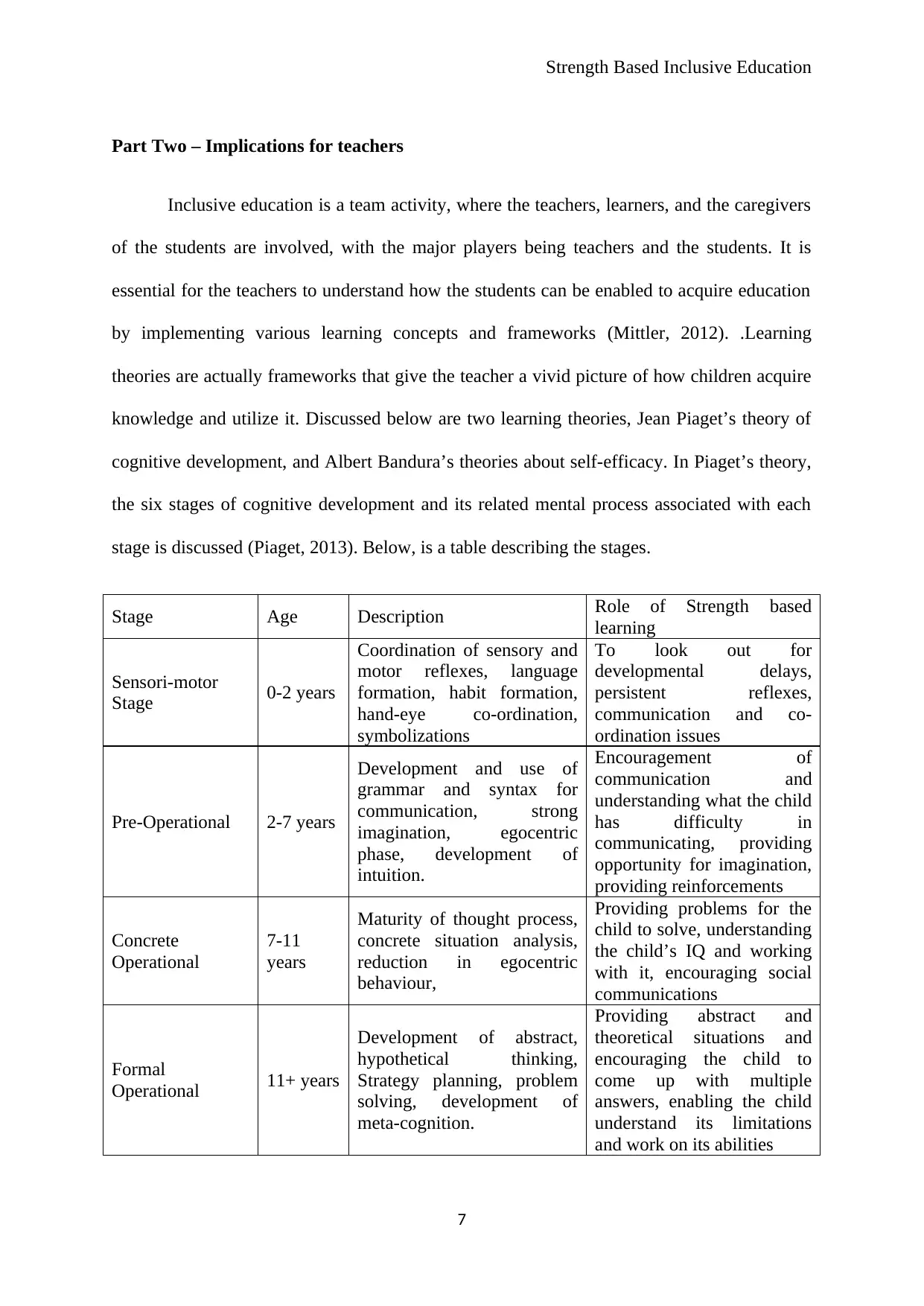
Strength Based Inclusive Education
Part Two – Implications for teachers
Inclusive education is a team activity, where the teachers, learners, and the caregivers
of the students are involved, with the major players being teachers and the students. It is
essential for the teachers to understand how the students can be enabled to acquire education
by implementing various learning concepts and frameworks (Mittler, 2012). .Learning
theories are actually frameworks that give the teacher a vivid picture of how children acquire
knowledge and utilize it. Discussed below are two learning theories, Jean Piaget’s theory of
cognitive development, and Albert Bandura’s theories about self-efficacy. In Piaget’s theory,
the six stages of cognitive development and its related mental process associated with each
stage is discussed (Piaget, 2013). Below, is a table describing the stages.
Stage Age Description Role of Strength based
learning
Sensori-motor
Stage 0-2 years
Coordination of sensory and
motor reflexes, language
formation, habit formation,
hand-eye co-ordination,
symbolizations
To look out for
developmental delays,
persistent reflexes,
communication and co-
ordination issues
Pre-Operational 2-7 years
Development and use of
grammar and syntax for
communication, strong
imagination, egocentric
phase, development of
intuition.
Encouragement of
communication and
understanding what the child
has difficulty in
communicating, providing
opportunity for imagination,
providing reinforcements
Concrete
Operational
7-11
years
Maturity of thought process,
concrete situation analysis,
reduction in egocentric
behaviour,
Providing problems for the
child to solve, understanding
the child’s IQ and working
with it, encouraging social
communications
Formal
Operational 11+ years
Development of abstract,
hypothetical thinking,
Strategy planning, problem
solving, development of
meta-cognition.
Providing abstract and
theoretical situations and
encouraging the child to
come up with multiple
answers, enabling the child
understand its limitations
and work on its abilities
7
Part Two – Implications for teachers
Inclusive education is a team activity, where the teachers, learners, and the caregivers
of the students are involved, with the major players being teachers and the students. It is
essential for the teachers to understand how the students can be enabled to acquire education
by implementing various learning concepts and frameworks (Mittler, 2012). .Learning
theories are actually frameworks that give the teacher a vivid picture of how children acquire
knowledge and utilize it. Discussed below are two learning theories, Jean Piaget’s theory of
cognitive development, and Albert Bandura’s theories about self-efficacy. In Piaget’s theory,
the six stages of cognitive development and its related mental process associated with each
stage is discussed (Piaget, 2013). Below, is a table describing the stages.
Stage Age Description Role of Strength based
learning
Sensori-motor
Stage 0-2 years
Coordination of sensory and
motor reflexes, language
formation, habit formation,
hand-eye co-ordination,
symbolizations
To look out for
developmental delays,
persistent reflexes,
communication and co-
ordination issues
Pre-Operational 2-7 years
Development and use of
grammar and syntax for
communication, strong
imagination, egocentric
phase, development of
intuition.
Encouragement of
communication and
understanding what the child
has difficulty in
communicating, providing
opportunity for imagination,
providing reinforcements
Concrete
Operational
7-11
years
Maturity of thought process,
concrete situation analysis,
reduction in egocentric
behaviour,
Providing problems for the
child to solve, understanding
the child’s IQ and working
with it, encouraging social
communications
Formal
Operational 11+ years
Development of abstract,
hypothetical thinking,
Strategy planning, problem
solving, development of
meta-cognition.
Providing abstract and
theoretical situations and
encouraging the child to
come up with multiple
answers, enabling the child
understand its limitations
and work on its abilities
7
Paraphrase This Document
Need a fresh take? Get an instant paraphrase of this document with our AI Paraphraser
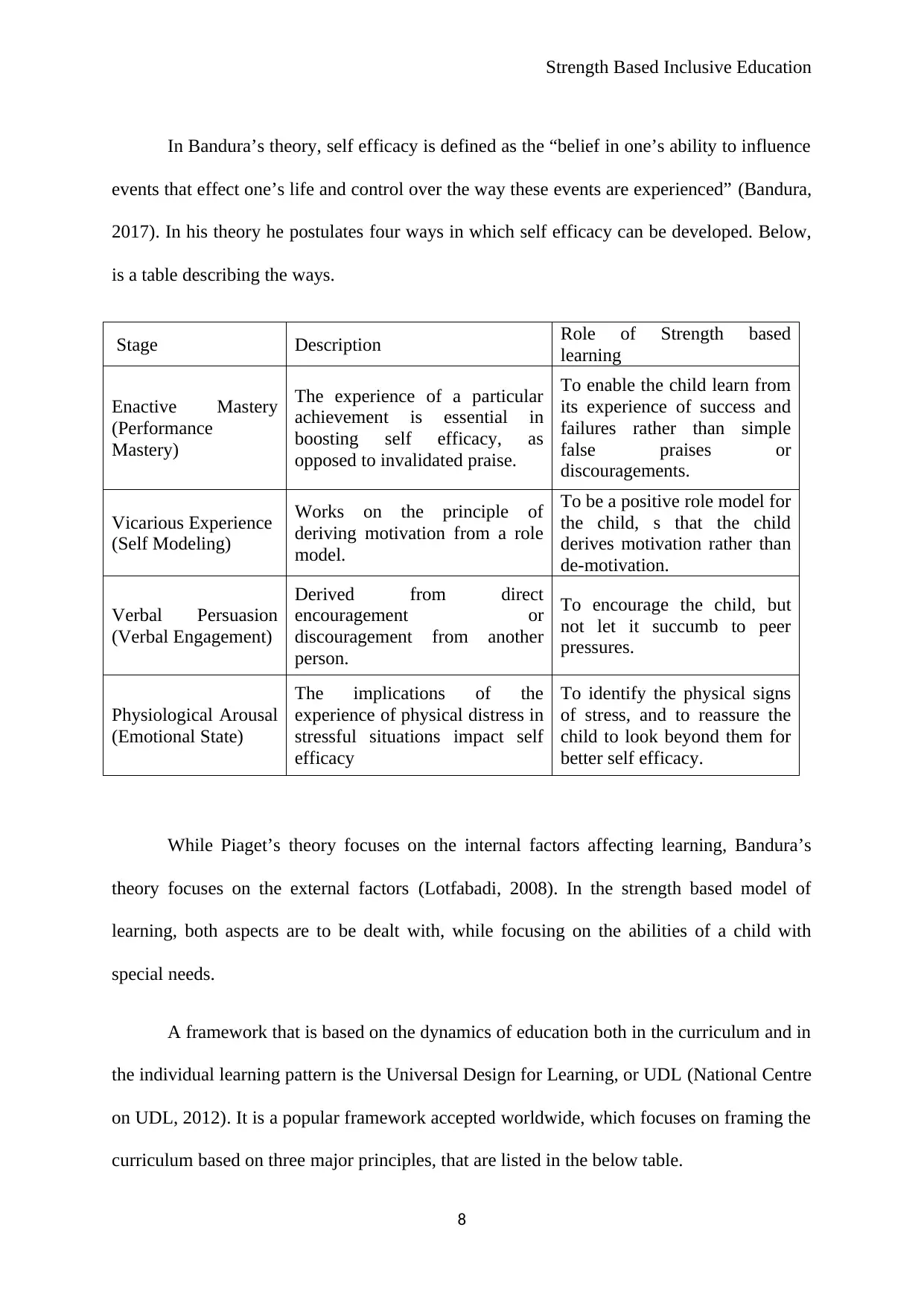
Strength Based Inclusive Education
In Bandura’s theory, self efficacy is defined as the “belief in one’s ability to influence
events that effect one’s life and control over the way these events are experienced” (Bandura,
2017). In his theory he postulates four ways in which self efficacy can be developed. Below,
is a table describing the ways.
Stage Description Role of Strength based
learning
Enactive Mastery
(Performance
Mastery)
The experience of a particular
achievement is essential in
boosting self efficacy, as
opposed to invalidated praise.
To enable the child learn from
its experience of success and
failures rather than simple
false praises or
discouragements.
Vicarious Experience
(Self Modeling)
Works on the principle of
deriving motivation from a role
model.
To be a positive role model for
the child, s that the child
derives motivation rather than
de-motivation.
Verbal Persuasion
(Verbal Engagement)
Derived from direct
encouragement or
discouragement from another
person.
To encourage the child, but
not let it succumb to peer
pressures.
Physiological Arousal
(Emotional State)
The implications of the
experience of physical distress in
stressful situations impact self
efficacy
To identify the physical signs
of stress, and to reassure the
child to look beyond them for
better self efficacy.
While Piaget’s theory focuses on the internal factors affecting learning, Bandura’s
theory focuses on the external factors (Lotfabadi, 2008). In the strength based model of
learning, both aspects are to be dealt with, while focusing on the abilities of a child with
special needs.
A framework that is based on the dynamics of education both in the curriculum and in
the individual learning pattern is the Universal Design for Learning, or UDL (National Centre
on UDL, 2012). It is a popular framework accepted worldwide, which focuses on framing the
curriculum based on three major principles, that are listed in the below table.
8
In Bandura’s theory, self efficacy is defined as the “belief in one’s ability to influence
events that effect one’s life and control over the way these events are experienced” (Bandura,
2017). In his theory he postulates four ways in which self efficacy can be developed. Below,
is a table describing the ways.
Stage Description Role of Strength based
learning
Enactive Mastery
(Performance
Mastery)
The experience of a particular
achievement is essential in
boosting self efficacy, as
opposed to invalidated praise.
To enable the child learn from
its experience of success and
failures rather than simple
false praises or
discouragements.
Vicarious Experience
(Self Modeling)
Works on the principle of
deriving motivation from a role
model.
To be a positive role model for
the child, s that the child
derives motivation rather than
de-motivation.
Verbal Persuasion
(Verbal Engagement)
Derived from direct
encouragement or
discouragement from another
person.
To encourage the child, but
not let it succumb to peer
pressures.
Physiological Arousal
(Emotional State)
The implications of the
experience of physical distress in
stressful situations impact self
efficacy
To identify the physical signs
of stress, and to reassure the
child to look beyond them for
better self efficacy.
While Piaget’s theory focuses on the internal factors affecting learning, Bandura’s
theory focuses on the external factors (Lotfabadi, 2008). In the strength based model of
learning, both aspects are to be dealt with, while focusing on the abilities of a child with
special needs.
A framework that is based on the dynamics of education both in the curriculum and in
the individual learning pattern is the Universal Design for Learning, or UDL (National Centre
on UDL, 2012). It is a popular framework accepted worldwide, which focuses on framing the
curriculum based on three major principles, that are listed in the below table.
8
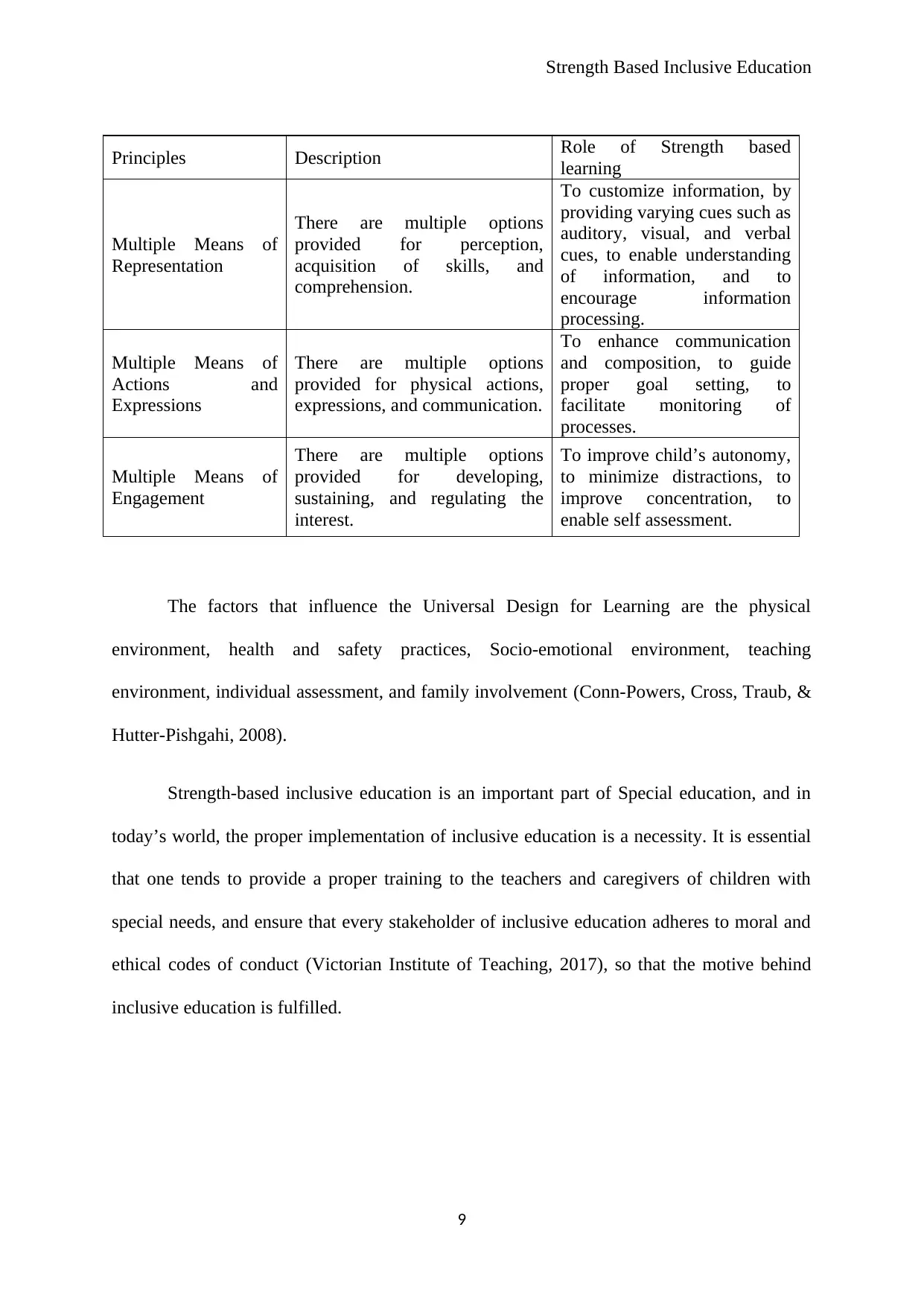
Strength Based Inclusive Education
Principles Description Role of Strength based
learning
Multiple Means of
Representation
There are multiple options
provided for perception,
acquisition of skills, and
comprehension.
To customize information, by
providing varying cues such as
auditory, visual, and verbal
cues, to enable understanding
of information, and to
encourage information
processing.
Multiple Means of
Actions and
Expressions
There are multiple options
provided for physical actions,
expressions, and communication.
To enhance communication
and composition, to guide
proper goal setting, to
facilitate monitoring of
processes.
Multiple Means of
Engagement
There are multiple options
provided for developing,
sustaining, and regulating the
interest.
To improve child’s autonomy,
to minimize distractions, to
improve concentration, to
enable self assessment.
The factors that influence the Universal Design for Learning are the physical
environment, health and safety practices, Socio-emotional environment, teaching
environment, individual assessment, and family involvement (Conn-Powers, Cross, Traub, &
Hutter-Pishgahi, 2008).
Strength-based inclusive education is an important part of Special education, and in
today’s world, the proper implementation of inclusive education is a necessity. It is essential
that one tends to provide a proper training to the teachers and caregivers of children with
special needs, and ensure that every stakeholder of inclusive education adheres to moral and
ethical codes of conduct (Victorian Institute of Teaching, 2017), so that the motive behind
inclusive education is fulfilled.
9
Principles Description Role of Strength based
learning
Multiple Means of
Representation
There are multiple options
provided for perception,
acquisition of skills, and
comprehension.
To customize information, by
providing varying cues such as
auditory, visual, and verbal
cues, to enable understanding
of information, and to
encourage information
processing.
Multiple Means of
Actions and
Expressions
There are multiple options
provided for physical actions,
expressions, and communication.
To enhance communication
and composition, to guide
proper goal setting, to
facilitate monitoring of
processes.
Multiple Means of
Engagement
There are multiple options
provided for developing,
sustaining, and regulating the
interest.
To improve child’s autonomy,
to minimize distractions, to
improve concentration, to
enable self assessment.
The factors that influence the Universal Design for Learning are the physical
environment, health and safety practices, Socio-emotional environment, teaching
environment, individual assessment, and family involvement (Conn-Powers, Cross, Traub, &
Hutter-Pishgahi, 2008).
Strength-based inclusive education is an important part of Special education, and in
today’s world, the proper implementation of inclusive education is a necessity. It is essential
that one tends to provide a proper training to the teachers and caregivers of children with
special needs, and ensure that every stakeholder of inclusive education adheres to moral and
ethical codes of conduct (Victorian Institute of Teaching, 2017), so that the motive behind
inclusive education is fulfilled.
9
⊘ This is a preview!⊘
Do you want full access?
Subscribe today to unlock all pages.

Trusted by 1+ million students worldwide
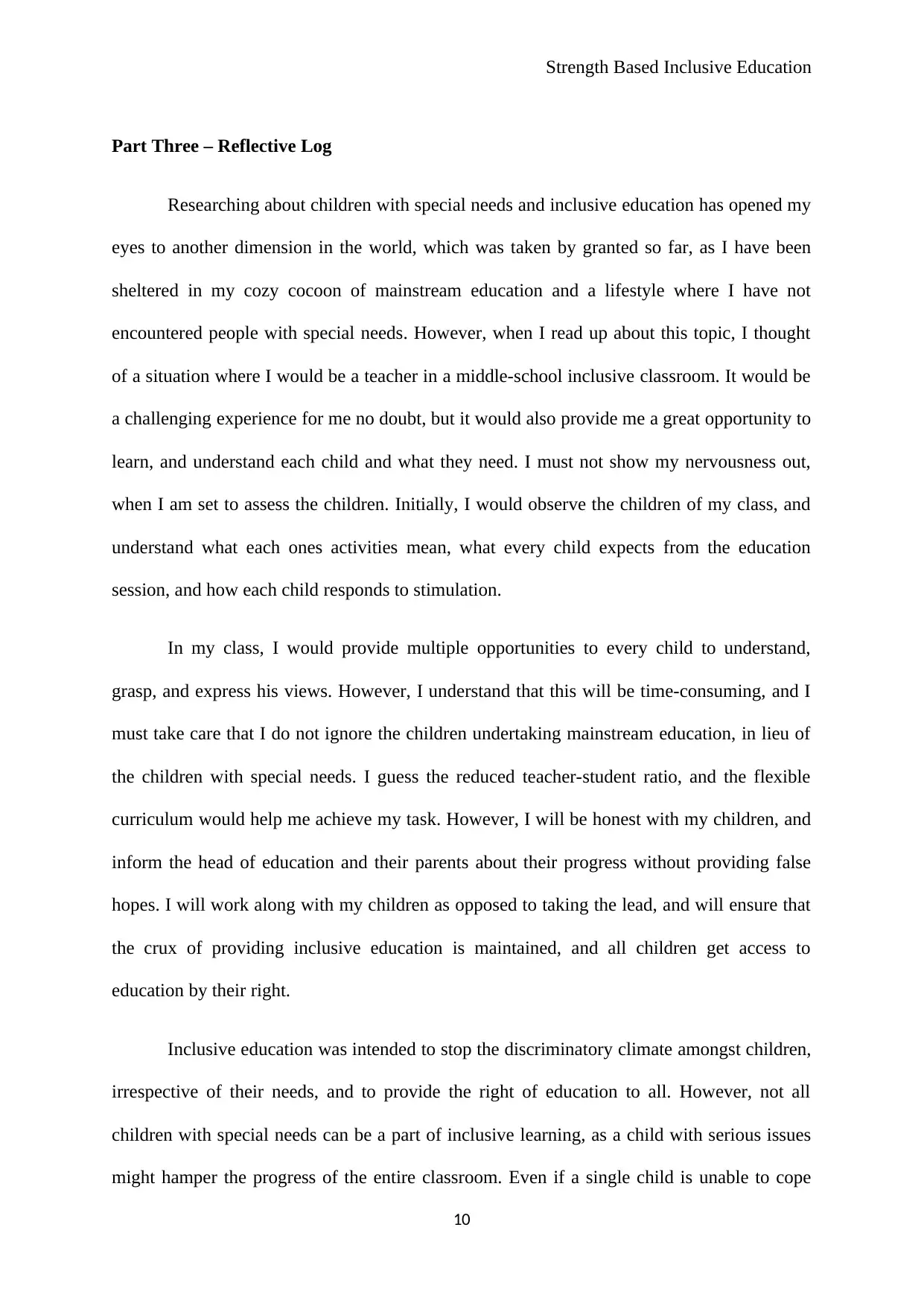
Strength Based Inclusive Education
Part Three – Reflective Log
Researching about children with special needs and inclusive education has opened my
eyes to another dimension in the world, which was taken by granted so far, as I have been
sheltered in my cozy cocoon of mainstream education and a lifestyle where I have not
encountered people with special needs. However, when I read up about this topic, I thought
of a situation where I would be a teacher in a middle-school inclusive classroom. It would be
a challenging experience for me no doubt, but it would also provide me a great opportunity to
learn, and understand each child and what they need. I must not show my nervousness out,
when I am set to assess the children. Initially, I would observe the children of my class, and
understand what each ones activities mean, what every child expects from the education
session, and how each child responds to stimulation.
In my class, I would provide multiple opportunities to every child to understand,
grasp, and express his views. However, I understand that this will be time-consuming, and I
must take care that I do not ignore the children undertaking mainstream education, in lieu of
the children with special needs. I guess the reduced teacher-student ratio, and the flexible
curriculum would help me achieve my task. However, I will be honest with my children, and
inform the head of education and their parents about their progress without providing false
hopes. I will work along with my children as opposed to taking the lead, and will ensure that
the crux of providing inclusive education is maintained, and all children get access to
education by their right.
Inclusive education was intended to stop the discriminatory climate amongst children,
irrespective of their needs, and to provide the right of education to all. However, not all
children with special needs can be a part of inclusive learning, as a child with serious issues
might hamper the progress of the entire classroom. Even if a single child is unable to cope
10
Part Three – Reflective Log
Researching about children with special needs and inclusive education has opened my
eyes to another dimension in the world, which was taken by granted so far, as I have been
sheltered in my cozy cocoon of mainstream education and a lifestyle where I have not
encountered people with special needs. However, when I read up about this topic, I thought
of a situation where I would be a teacher in a middle-school inclusive classroom. It would be
a challenging experience for me no doubt, but it would also provide me a great opportunity to
learn, and understand each child and what they need. I must not show my nervousness out,
when I am set to assess the children. Initially, I would observe the children of my class, and
understand what each ones activities mean, what every child expects from the education
session, and how each child responds to stimulation.
In my class, I would provide multiple opportunities to every child to understand,
grasp, and express his views. However, I understand that this will be time-consuming, and I
must take care that I do not ignore the children undertaking mainstream education, in lieu of
the children with special needs. I guess the reduced teacher-student ratio, and the flexible
curriculum would help me achieve my task. However, I will be honest with my children, and
inform the head of education and their parents about their progress without providing false
hopes. I will work along with my children as opposed to taking the lead, and will ensure that
the crux of providing inclusive education is maintained, and all children get access to
education by their right.
Inclusive education was intended to stop the discriminatory climate amongst children,
irrespective of their needs, and to provide the right of education to all. However, not all
children with special needs can be a part of inclusive learning, as a child with serious issues
might hamper the progress of the entire classroom. Even if a single child is unable to cope
10
Paraphrase This Document
Need a fresh take? Get an instant paraphrase of this document with our AI Paraphraser
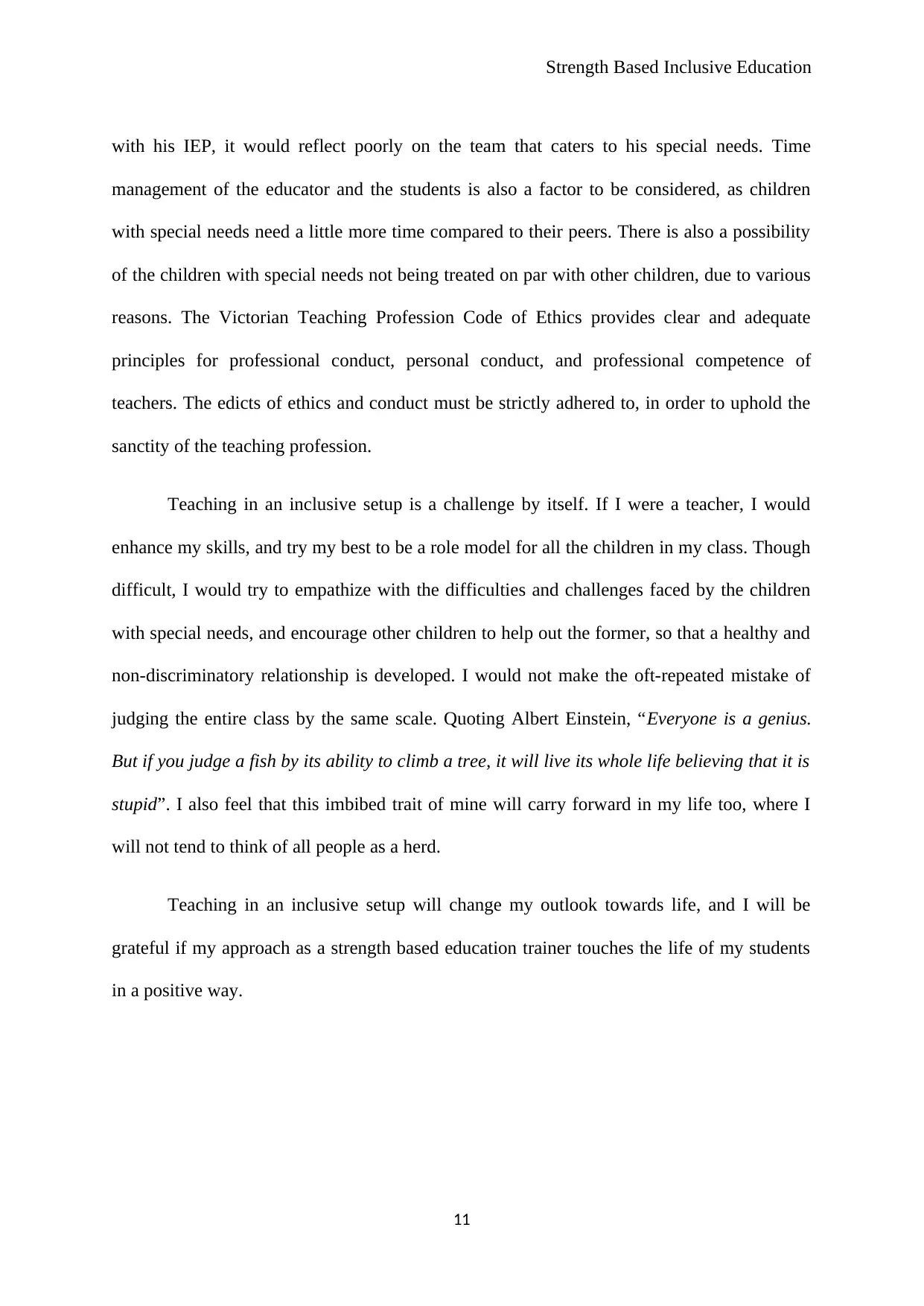
Strength Based Inclusive Education
with his IEP, it would reflect poorly on the team that caters to his special needs. Time
management of the educator and the students is also a factor to be considered, as children
with special needs need a little more time compared to their peers. There is also a possibility
of the children with special needs not being treated on par with other children, due to various
reasons. The Victorian Teaching Profession Code of Ethics provides clear and adequate
principles for professional conduct, personal conduct, and professional competence of
teachers. The edicts of ethics and conduct must be strictly adhered to, in order to uphold the
sanctity of the teaching profession.
Teaching in an inclusive setup is a challenge by itself. If I were a teacher, I would
enhance my skills, and try my best to be a role model for all the children in my class. Though
difficult, I would try to empathize with the difficulties and challenges faced by the children
with special needs, and encourage other children to help out the former, so that a healthy and
non-discriminatory relationship is developed. I would not make the oft-repeated mistake of
judging the entire class by the same scale. Quoting Albert Einstein, “Everyone is a genius.
But if you judge a fish by its ability to climb a tree, it will live its whole life believing that it is
stupid”. I also feel that this imbibed trait of mine will carry forward in my life too, where I
will not tend to think of all people as a herd.
Teaching in an inclusive setup will change my outlook towards life, and I will be
grateful if my approach as a strength based education trainer touches the life of my students
in a positive way.
11
with his IEP, it would reflect poorly on the team that caters to his special needs. Time
management of the educator and the students is also a factor to be considered, as children
with special needs need a little more time compared to their peers. There is also a possibility
of the children with special needs not being treated on par with other children, due to various
reasons. The Victorian Teaching Profession Code of Ethics provides clear and adequate
principles for professional conduct, personal conduct, and professional competence of
teachers. The edicts of ethics and conduct must be strictly adhered to, in order to uphold the
sanctity of the teaching profession.
Teaching in an inclusive setup is a challenge by itself. If I were a teacher, I would
enhance my skills, and try my best to be a role model for all the children in my class. Though
difficult, I would try to empathize with the difficulties and challenges faced by the children
with special needs, and encourage other children to help out the former, so that a healthy and
non-discriminatory relationship is developed. I would not make the oft-repeated mistake of
judging the entire class by the same scale. Quoting Albert Einstein, “Everyone is a genius.
But if you judge a fish by its ability to climb a tree, it will live its whole life believing that it is
stupid”. I also feel that this imbibed trait of mine will carry forward in my life too, where I
will not tend to think of all people as a herd.
Teaching in an inclusive setup will change my outlook towards life, and I will be
grateful if my approach as a strength based education trainer touches the life of my students
in a positive way.
11
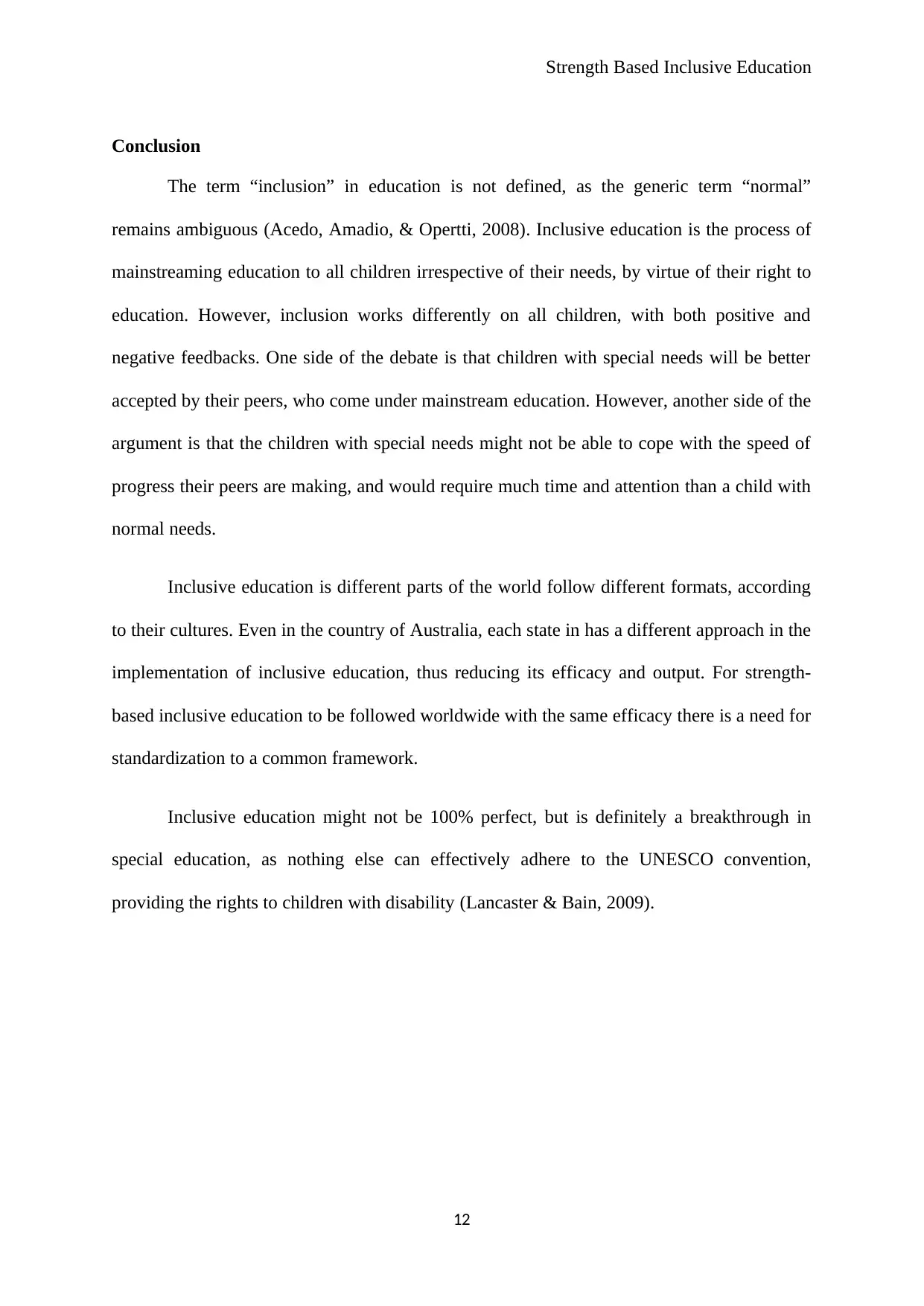
Strength Based Inclusive Education
Conclusion
The term “inclusion” in education is not defined, as the generic term “normal”
remains ambiguous (Acedo, Amadio, & Opertti, 2008). Inclusive education is the process of
mainstreaming education to all children irrespective of their needs, by virtue of their right to
education. However, inclusion works differently on all children, with both positive and
negative feedbacks. One side of the debate is that children with special needs will be better
accepted by their peers, who come under mainstream education. However, another side of the
argument is that the children with special needs might not be able to cope with the speed of
progress their peers are making, and would require much time and attention than a child with
normal needs.
Inclusive education is different parts of the world follow different formats, according
to their cultures. Even in the country of Australia, each state in has a different approach in the
implementation of inclusive education, thus reducing its efficacy and output. For strength-
based inclusive education to be followed worldwide with the same efficacy there is a need for
standardization to a common framework.
Inclusive education might not be 100% perfect, but is definitely a breakthrough in
special education, as nothing else can effectively adhere to the UNESCO convention,
providing the rights to children with disability (Lancaster & Bain, 2009).
12
Conclusion
The term “inclusion” in education is not defined, as the generic term “normal”
remains ambiguous (Acedo, Amadio, & Opertti, 2008). Inclusive education is the process of
mainstreaming education to all children irrespective of their needs, by virtue of their right to
education. However, inclusion works differently on all children, with both positive and
negative feedbacks. One side of the debate is that children with special needs will be better
accepted by their peers, who come under mainstream education. However, another side of the
argument is that the children with special needs might not be able to cope with the speed of
progress their peers are making, and would require much time and attention than a child with
normal needs.
Inclusive education is different parts of the world follow different formats, according
to their cultures. Even in the country of Australia, each state in has a different approach in the
implementation of inclusive education, thus reducing its efficacy and output. For strength-
based inclusive education to be followed worldwide with the same efficacy there is a need for
standardization to a common framework.
Inclusive education might not be 100% perfect, but is definitely a breakthrough in
special education, as nothing else can effectively adhere to the UNESCO convention,
providing the rights to children with disability (Lancaster & Bain, 2009).
12
⊘ This is a preview!⊘
Do you want full access?
Subscribe today to unlock all pages.

Trusted by 1+ million students worldwide
1 out of 14
Related Documents
Your All-in-One AI-Powered Toolkit for Academic Success.
+13062052269
info@desklib.com
Available 24*7 on WhatsApp / Email
![[object Object]](/_next/static/media/star-bottom.7253800d.svg)
Unlock your academic potential
Copyright © 2020–2025 A2Z Services. All Rights Reserved. Developed and managed by ZUCOL.





